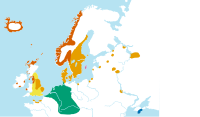| Old Norse | |
|---|---|
| Old Nordic, Old Scandinavian | |
| dǫnsk tunga ('Danish tongue') norrǿnt mál ('Northern speech') | |
| Native to | Scandinavia, Iceland, Faroe Islands, Greenland and other Norse settlements |
| Region | Nordic countries, Great Britain, Ireland, Isle of Man, Normandy, Newfoundland, the Volga and places in-between |
| Ethnicity | Norsemen and their descendants |
| Era | Evolved from Proto-Norse in the 8th century, developed into the various North Germanic languages by the 15th century |
Indo-European
| |
Early form | Proto-Norse (attested)
|
| Runic, later Latin (Old Norse alphabet) | |
| Language codes | |
| ISO 639-2 | non |
| ISO 639-3 | non |
| Glottolog | oldn1244 |
| Part of a series on |
| Old Norse |
|---|
 |
| WikiProject Norse history and culture |
| Part of a series on the |
| Norsemen |
|---|
 |
| WikiProject Norse history and culture |
Old Norse, also referred to as Old Nordic,[1] or Old Scandinavian, was a stage of development of North Germanic dialects before their final divergence into separate Nordic languages. Old Norse was spoken by inhabitants of Scandinavia and their overseas settlements and chronologically coincides with the Viking Age, the Christianization of Scandinavia, and the consolidation of Scandinavian kingdoms from about the 8th to the 15th centuries.[2]
The Proto-Norse language developed into Old Norse by the 8th century, and Old Norse began to develop into the modern North Germanic languages in the mid- to late 14th century, ending the language phase known as Old Norse. These dates, however, are not absolute, since written Old Norse is found well into the 15th century.[3][better source needed]
Old Norse was divided into three dialects: Old West Norse (Old West Nordic, often referred to as Old Norse),[4] Old East Norse (Old East Nordic), and Old Gutnish. Old West Norse and Old East Norse formed a dialect continuum, with no clear geographical boundary between them. Old East Norse traits were found in eastern Norway, although Old Norwegian is classified as Old West Norse, and Old West Norse traits were found in western Sweden. In what is present-day Denmark and Sweden, most speakers spoke Old East Norse. Though Old Gutnish is sometimes included in the Old East Norse dialect due to geographical associations, it developed its own unique features and shared in changes to both other branches.[5]
The 12th-century Icelandic Gray Goose Laws state that Swedes, Norwegians, Icelanders, and Danes spoke the same language, dǫnsk tunga ("Danish tongue"; speakers of Old East Norse would have said dansk tunga). Another term was norrœnt mál ("northern speech"). Today Old Norse has developed into the modern North Germanic languages Icelandic, Faroese, Norwegian, Danish, Swedish, and other North Germanic varieties of which Norwegian, Danish and Swedish retain considerable mutual intelligibility. Icelandic remains the most conservative language, such that in present-day Iceland, schoolchildren are able to read the 12th-century Icelandic sagas in the original language (in editions with normalised spelling).[6]
- ^ Josephson, Folke; Söhrman, Ingmar (29 August 2008). Interdependence of Diachronic and Synchronic Analyses. John Benjamins. ISBN 9789027290359. Archived from the original on 17 April 2023. Retrieved 7 January 2021.
- ^ König, Ekkehard; van der Auwera, Johan, eds. (2002). The Germanic Languages. Routledge. p. 38. ISBN 978-0415280792.
- ^ Torp & Vikør 1993.
- ^ König, Ekkehard; van der Auwera, Johan, eds. (2002). The Germanic Languages. Routledge. p. 38. ISBN 978-0415280792.
- ^ "Old Norse language". Encyclopedia Britannica. Archived from the original on 3 August 2020. Retrieved 5 August 2020.
- ^ Sanders, Ruth H. (2021). The Languages of Scandinavia: Seven Sisters of the North. University of Chicago Press. pp. 63–64. ISBN 978-0-226-75975-3.